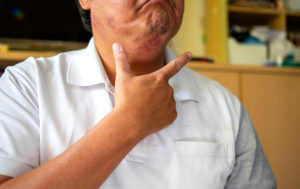Dr Kushnir and her staff visits house with suspected mold and moisture problem upon request and arranged time. Here is what we can do:
We recommend to make arrangements of the house visit at least 2 weeks prior as availability is limited.
Sick building syndrome (SBS) is a sickness affecting people living in a certain building (if they were healthy before). They claim to experience acute health problems that appear to be linked to time spent in a building. SBS is also used interchangeably with “building-related symptoms”, which orients the name of the condition around patients rather than a “sick” building.
A 1984 World Health Organization (WHO) report suggested up to 30% of new and remodeled buildings worldwide may be subject of complaints related to poor indoor air quality.
Sick building causes are frequently pinned down to flaws in:

One of the issues with indoor pollution is that symptoms do not start all together. Also, people may experience different symptoms, even in the same family. Yet, there are certain symptoms that are most common:
It can take weeks to months to develop these problems because they are not specific, and many people do not even know why they are getting sicker. Usually children, elderly and immunocompromised people are affected first.

Asthma is one of the diseases directly linked to contamination of the living spaces with molds and other organisms, such as dust mites. Environmental allergies to indoor proteins is also well-documented. It can lead to:
Legionnaire’s disease is due to contamination of cooling towers by legionella organisms. Legionella is also responsible for Pontiac fever. Legionnaire’s disease occurs predominantly in the middle aged and elderly adults whereas Pontiac fever occurs in young healthy adults, and has a very high secondary attack rate.
Humidifier fever is caused by breathing in water droplets from humidifiers heavily contaminated with microorganisms causing respiratory infections, asthma and extrinsic allergic alveolitis. The disease is noninfective in nature. The patient may have flu-like symptoms. It is sometimes called Monday Fever. Permanent lung damage does not occur.
The symptoms can be clinically defined and have clearly identifiable causes. The complainants may require prolonged recovery time after leaving the building.
It is important to note that complaints may also result from other cause like a preexisting illness or other allergies, job-related stress or dissatisfaction and psychosocial factors.

REFERENCES:
Sick–building syndrome. Lancet. 1997 Apr 5;349(9057):1013-6. doi: 10.1016/S0140-6736(96)07220-0.PMID: 9100639 Free article. Review.
Sick–building syndrome (SBS) is an increasingly common problem. Although objective physiological abnormalities are not generally found and permanent sequelae are rare, the symptoms of SBS can be uncomfortable, even disabling, and whole workplaces can be rende …
Neurologic and neuropsychiatric syndrome features of mold and mycotoxin exposure. Toxicol Ind Health. 2009 Oct-Nov;25(9-10):577-81. doi: 10.1177/0748233709348393.PMID: 19854819
Mold Exposure and Mitochondrial Antibodies. Altern Ther Health Med. 2020 Nov;26(6):44-47.PMID: 32088666
The medical effects of mold exposure. J Allergy Clin Immunol. 2006 Feb;117(2):326-33. doi: 10.1016/j.jaci.2005.12.001.PMID: 16514772 Review.
Read more
I work outside and have pretty serious allergies. Dr. Kushnir was recommended to me by a co-worker after a nasty allergy attack. She is everything claimed: professional, smart, friendly, and most importantly… effective. After a year of treatments, my severe seasonal allergies are greatly improved. I can spend time outside without ending up miserable, even when pollen counts are extremely high (as they have been this spring), and I can hang out with my friends’ pets without any problems. Dr. Kushnir is responsive and conscientious. If you have any allergy problems, give her a shot. Even if you’ve seen someone else. Seriously, she can help you.
I am thrilled to see that Dr. Kushnir is on Yelp ! She is an outstanding physician who has helped me with my medical challenges when every other professional from whom I sought treatment either did not understan
I’ve been coming to Dr. Kushnir for allergy shots for more than a year. She’s friendly and attentive, and she takes the time to explain the diagnoses and treatments. She seems well informed about new research in
Is 5 stars really the maximum I can give? Dr. Kushnir is an amazing doctor/ allergist that truly cares about her patients (not what type of insurance you have!). She is very good at explaining things in layman’s ter
Read more
Truly gifted… My family all out voted me because they wanted cats… I’m allergic and wanted to test the rest of the family. We went through the tests… A bit of a pain (duh…) and got the tests back. Glad we went because I’m apparently allergic to everything and my daughter was pre-asthmatic. We did an accelerated anti allergen program. I have had shots before but frankly, she is a master. Rarely does it hurt and when it does, its only worthy of a wince. She’s great with the kids and has strategies to help alleviate kids anxiety of those shots. We were able to reach the top dose in just a few months. We got our cats (not one… But two long haired cats) and we’re to the point where if I wanted to… I could put my face into these cats and breathe deeply with zero reaction. She’s also very up to date on the Gluten and Dairy intolerance information which has been helpful for me. Dr Kushnir has her act together… She’s a scientist as well as a doctor too. The benefit is that she’s usually the first to know about something… But she’s willing to look into the latest study without going off on a long monologue adhering to old and outdated models of doctoring. I highly recommend Dr Kushnir and her staff. BYW… food allergies can’t be helped, only avoided.